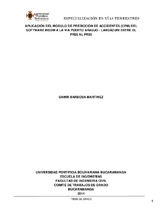Mostrar el registro sencillo del ítem
Aplicación del módulo de predicción de accidentes (CPM) del Software IHSDM a la vía Puerto Araujo - Landázuri entre el PR26 al PR30
| dc.contributor.advisor | Director. Flórez Abril, Angélica | |
| dc.contributor.author | Barbosa Martínez, Samir | |
| dc.coverage.temporal | 2014 | |
| dc.date.accessioned | 2022-05-31T22:13:32Z | |
| dc.date.available | 2022-05-31T22:13:32Z | |
| dc.date.issued | 2014-05 | |
| dc.identifier.uri | http://hdl.handle.net/20.500.11912/10084 | |
| dc.description | 74p.: (pdf); gráficas; tablas. | spa |
| dc.description.abstract | Desde hace algunos años a nivel nacional se ha venido trabajando en la reducción de la tasa de accidentes que se presentan en las vías del país, esto en gran medida por factores de geometría vial e imprudencias de los conductores. Debido a esto desde hace algún tiempo a nivel mundial se investigan herramientas que permitan realizar evaluaciones viales para establecer soluciones a realizar en los sectores de conflicto a causa de éstos altos niveles. La transversal del Carare, al cual pertenece el tramo de estudio, se ha convertido en un potencial eje vial que permite una más rápida comunicación de occidente a oriente y viceversa en el departamento de Santander. Ésta como muchas otras vías del país tiene falencias de infraestructura las cuales en su mayoría se convierten en puntos de alta accidentalidad. Es así como la finalidad del módulo de predicción de accidentalidad de IHSDM es identificar puntos de mayor posibilidad de accidentes a partir de datos históricos e inventarios de la geometría y estructuras complementarias de la vía, con el fin buscar soluciones que permitan reducir al máximo la posibilidad de ocurrencia de éstos. | spa |
| dc.description.abstract | For some years now, there has been working nationally on the reduction to the accidents rates happening on country roads, given in a greater scale to road geometry factors and drivers imprudence. Due to this, for some time now it’s been investigated globally tools that allows roads evaluations to establish solutions to implement at the troubled sectors because of this high rate. The Carare crossroad, the one which belongs to the studied section, has become in a potential road axis which let a faster travelling between west and east and vice versa inside the department of Santander. This one, as many other roads of the country have infrastructure failures which in the majority of cases becomes in a high car accident point. This is how the purpose of the accident predictive module of IHSDM is to identify the points along the road with the highest accident probability, taking on count historical data and geometrical inventory and complementary structures of the road, seeking solutions that allows reduce to the maximum the probability of happening the mentioned accidents. | eng |
| dc.format.mimetype | application/pdf | |
| dc.language.iso | spa | spa |
| dc.publisher | Universidad Pontificia Bolivariana | spa |
| dc.rights | Attribution-NonCommercial-NoDerivatives 4.0 International | * |
| dc.rights.uri | http://creativecommons.org/licenses/by-nc-nd/4.0/ | * |
| dc.subject | Especialización en Vías Terrestres | spa |
| dc.subject | Señales y señalización | spa |
| dc.subject | Carreteras - Diseño y construcción | spa |
| dc.subject | Software - IHSDM | spa |
| dc.subject | Accidentes de tránsito | spa |
| dc.title | Aplicación del módulo de predicción de accidentes (CPM) del Software IHSDM a la vía Puerto Araujo - Landázuri entre el PR26 al PR30 | spa |
| dc.type | Especialización | spa |
| dc.publisher.department | Escuela de Ingenierías | spa |
| dc.publisher.program | Especialización en Vías Terrestres | spa |
| dc.type.hasVersion | publishedVersion | spa |
| dc.description.sectional | Bucaramanga | spa |
| dc.description.degreename | Especialista en Vías Terrestres | spa |
Ficheros en el ítem
Este ítem aparece en la(s) siguiente(s) colección(ones)
-
Trabajos de grado [6440]
Monografías, artículos, informes, proyecto de grado


